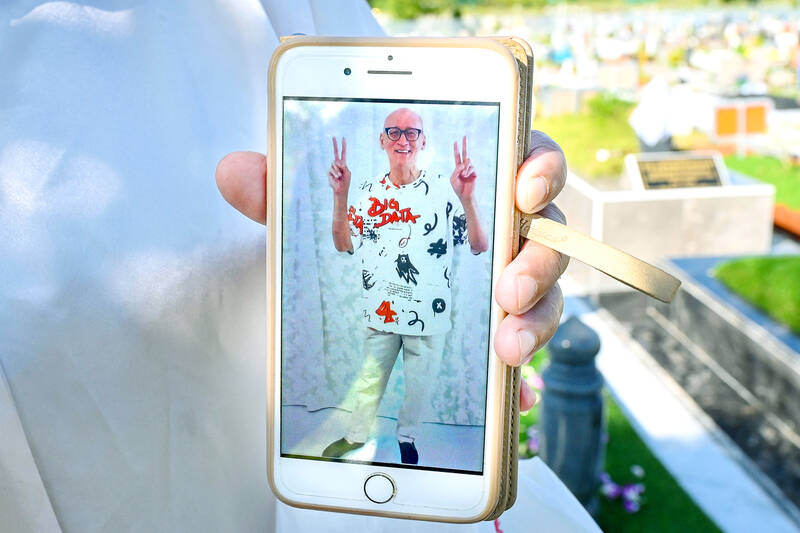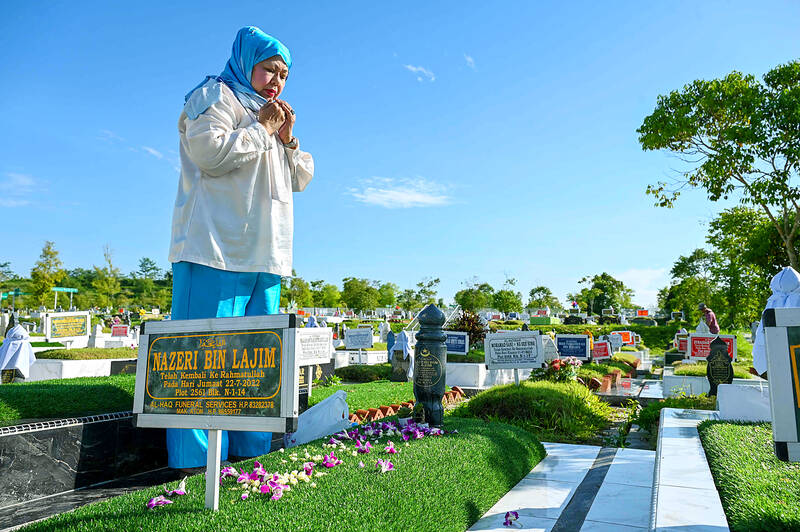Death row inmate Nazeri Lajim beams at the camera, fingers raised in a “V” sign, wearing a shirt emblazoned with large motifs and showing no signs of his impending hanging. Taken days before his execution at Singapore’s Changi prison, the picture is among the last mementoes Lajim’s family has of the 64-year-old, who was executed on charges of drug trafficking.
In the city-state, prison officials offer a photo shoot shortly before an inmate’s hanging, providing simple props like chairs and other items.
“When I see his photograph he’s (a) very healthy man, he’s very good looking man... his face shines,” sais Nazira Lajim Hertslet, his sister. “I was very upset... that he was taken away just like that.”

Photo: AFP
Singapore imposes the death penalty for a litany of crimes, including murder and some forms of kidnapping.
It also has some of the world’s toughest anti-drug laws: trafficking more than 500 grams of cannabis can result in the death penalty.
Thirteen people have been hanged since the government resumed executions following a two-year hiatus in place during the COVID-19 pandemic.

Photo: AFP
In a program first introduced in the 1990s, they were offered the option to pose for photographs before their death.
‘QUITE CRUEL’
Usually taken against a pale-green flowery backdrop, the photos offer a glimpse into the last days of the condemned.
The Singapore Prison Service says participation in the program is voluntary, and that the photo shoots “allow family members to have recent photographs of their loved one.”
Relatives, however, say they have mixed feelings about the practice.
“Actually it’s quite cruel to do such thing, to take photograph on his last days,” said Hertslet, pointing to the horror inmates might feel knowing it was their last time being photographed alive.
“But at least we have his last photo for memories when he’s really gone,” she added.
Nazeri was hanged last year for trafficking more than 33 grams of heroin.
In his sister’s favorite photograph of him, he is wearing a white Muslim prayer robe, his hands clasped in front, looking at the camera.
‘VENEER OF THOUGHTFULNESS’
Little information is publicly available about Singapore’s death row inmates.
The Transformative Justice Collective, which provides support to families of death row prisoners and advocates for the abolition of the death penalty, estimates about 53 people are on death row, the majority convicted of drug offenses. Authorities generally notify inmates and their families about a week before an execution.
During that time, the inmate is allowed to have daily visitors, but they are separated by a glass pane and no physical contact is allowed, according to the TJC.
Spiritual counselors are also provided.
Kokila Annamalai, a TJC activist, said the photo shoots are an attempt “to lend a veneer of thoughtfulness” to the executions.
In the photo sessions, prisoners can strike a particular pose or wear clothing that means something to a family member, she said.
“And so, I think that the photos are also like love letters to them.”
‘EVERY NIGHT I CRY’
Rights groups, including Amnesty International, have long called on Singapore to abolish capital punishment, but the government insists it is an effective deterrent against crime. Tangaraju Suppiah, a 46-year-old Singaporean, was hanged in April for conspiring to smuggle one kilogram of cannabis.
“Every night I cry and every night I think about him,” said his sister Leelavathy Suppiah.
Tangaraju initially refused to do the photo shoot, but relented after his family persuaded him, she said.
Leelavathy has framed a photograph of him smiling, holding his thumb and forefinger in a heart shape — a pose popularized by K-pop stars.
“I’m very happy when I see the photos. At least he’s there in the photos,” she said, speaking in English. “This is the photo our family members everybody like because he smile,” she added.
Still, she wondered what must have been going through her brother’s mind in his final days.“They know they’re going to die,” she said. “It’s cruel, you know?”
WHITE SNEAKERS
Kalwant Singh’s family bought him a pair of white sneakers, which he wore with a T-shirt, sweatpants and a broad smile in one photograph.
Sonia Tarlochan Kaur, the 31-year-old Malaysian’s sister, said he only got about half an hour during the photo shoot to wear the shoes, and so ran around the cell block to make the most of them.
After Kalwant’s execution for heroin trafficking last year, Sonia said she cannot bring herself to look at the photographs.
“They could have just given me that half an hour to hug him tight.”

June 9 to June 15 A photo of two men riding trendy high-wheel Penny-Farthing bicycles past a Qing Dynasty gate aptly captures the essence of Taipei in 1897 — a newly colonized city on the cusp of great change. The Japanese began making significant modifications to the cityscape in 1899, tearing down Qing-era structures, widening boulevards and installing Western-style infrastructure and buildings. The photographer, Minosuke Imamura, only spent a year in Taiwan as a cartographer for the governor-general’s office, but he left behind a treasure trove of 130 images showing life at the onset of Japanese rule, spanning July 1897 to

In an interview posted online by United Daily News (UDN) on May 26, current Chinese Nationalist Party (KMT) Chairman Eric Chu (朱立倫) was asked about Taichung Mayor Lu Shiow-yen (盧秀燕) replacing him as party chair. Though not yet officially running, by the customs of Taiwan politics, Lu has been signalling she is both running for party chair and to be the party’s 2028 presidential candidate. She told an international media outlet that she was considering a run. She also gave a speech in Keelung on national priorities and foreign affairs. For details, see the May 23 edition of this column,

One of the most important gripes that Taiwanese have about the Democratic Progressive Party (DPP) is that it has failed to deliver concretely on higher wages, housing prices and other bread-and-butter issues. The parallel complaint is that the DPP cares only about glamor issues, such as removing markers of Chinese Nationalist Party (KMT) colonialism by renaming them, or what the KMT codes as “de-Sinification.” Once again, as a critical election looms, the DPP is presenting evidence for that charge. The KMT was quick to jump on the recent proposal of the Ministry of the Interior (MOI) to rename roads that symbolize

Jade Mountain (玉山) — Taiwan’s highest peak — is the ultimate goal for those attempting a through-hike of the Mountains to Sea National Greenway (山海圳國家綠道), and that’s precisely where we’re headed in this final installment of a quartet of articles covering the Greenway. Picking up the trail at the Tsou tribal villages of Dabang and Tefuye, it’s worth stocking up on provisions before setting off, since — aside from the scant offerings available on the mountain’s Dongpu Lodge (東埔山莊) and Paiyun Lodge’s (排雲山莊) meal service — there’s nowhere to get food from here on out. TEFUYE HISTORIC TRAIL The journey recommences with